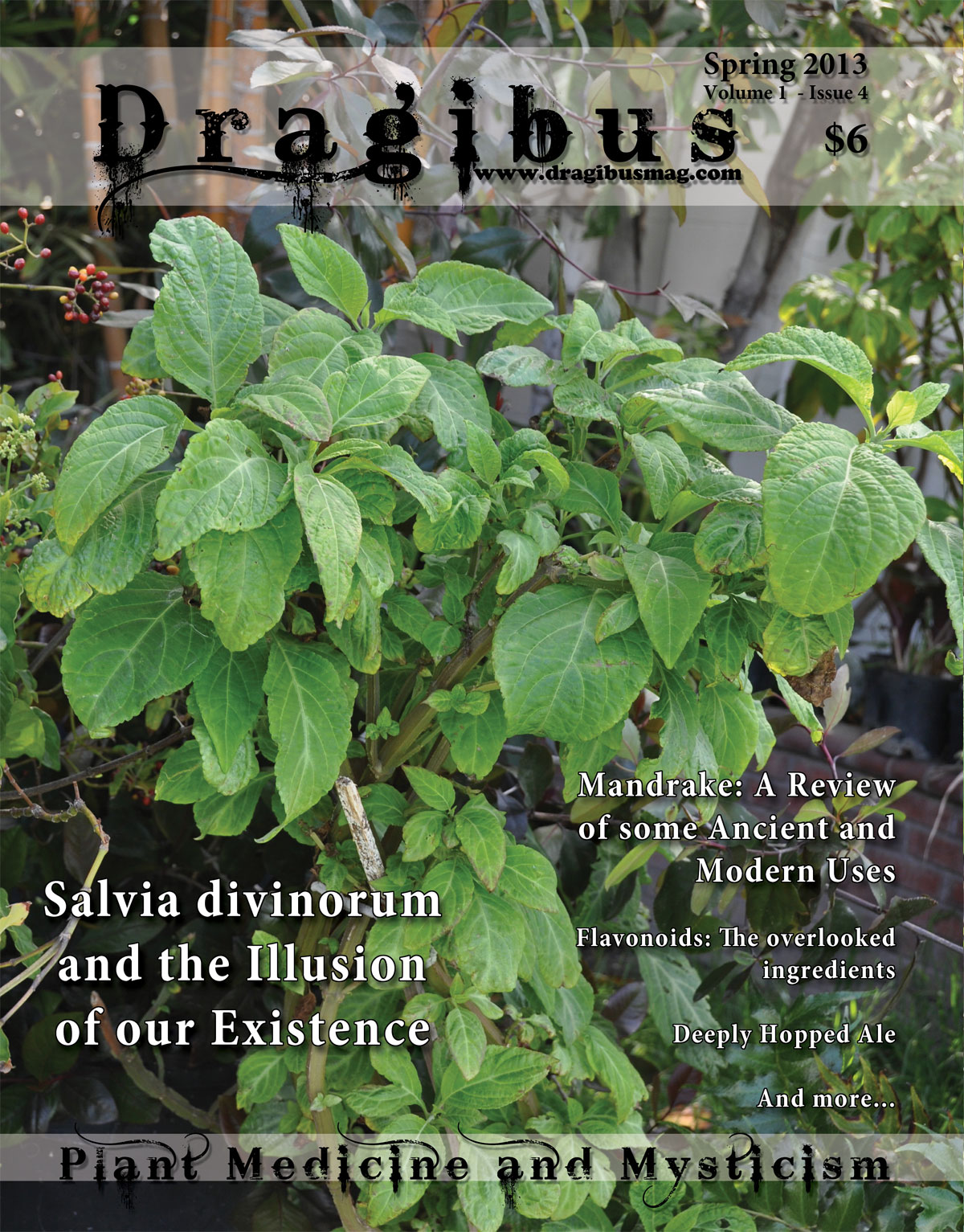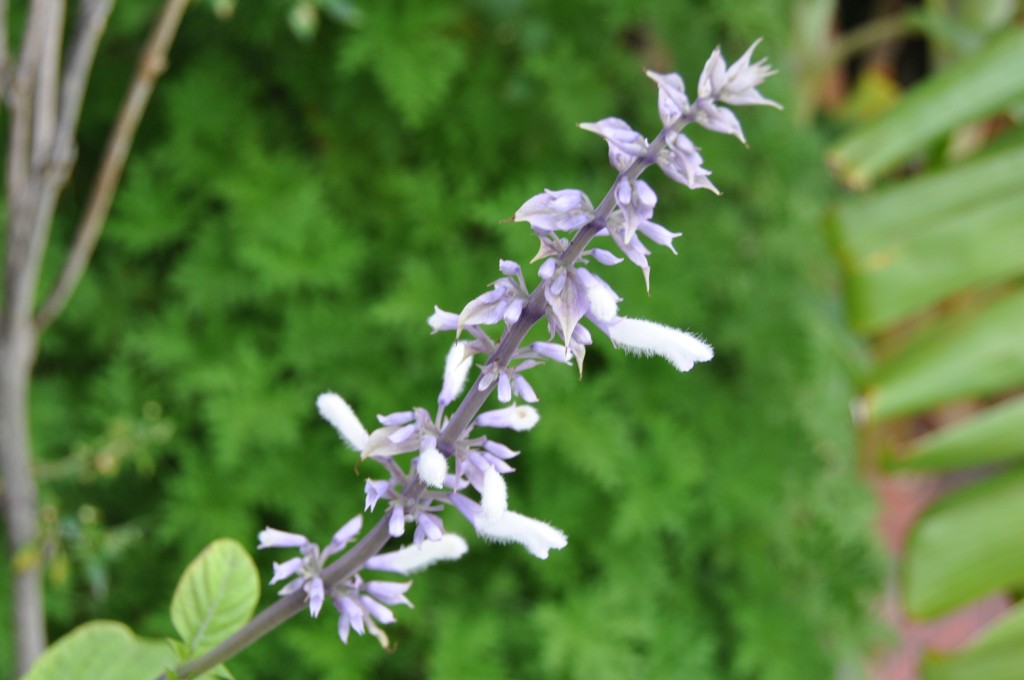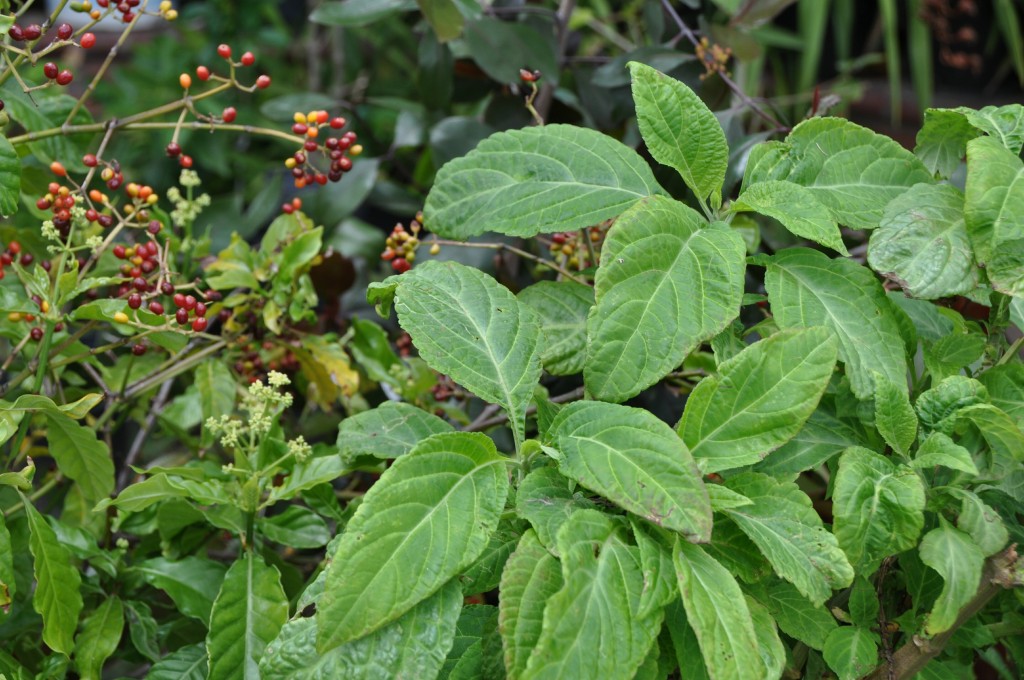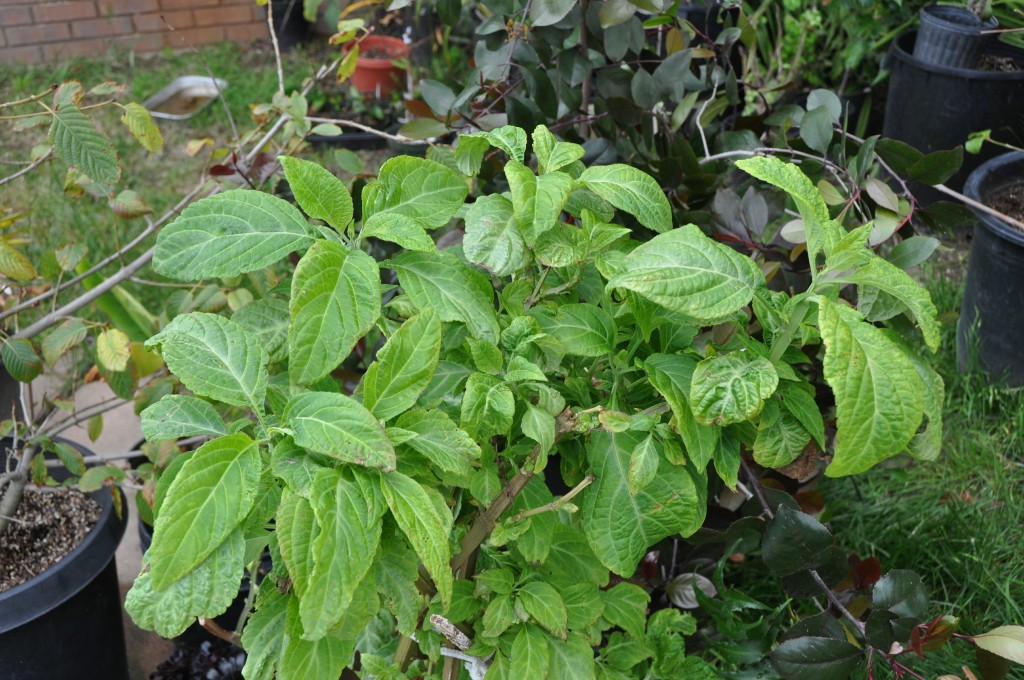Salvia Divinorum And The Illusion Of Our Existence
By Ross Heaven
Photos by misplant
In shamanic terms (and as explorers of consciousness discover for themselves) all entheogenic plants have a personality and purpose. This is usually complex and not easy to summarise in a few words. However, if I had to summarise, I might say for example that ayahuasca takes us out of the limited earthbound view we have of ourselves and into the wider spiritual universe so we can explore the fullness of our potential. On the other hand, San Pedro brings back to Earth with a new spiritual consciousness so we see our world and ourselves as ensouled.
Where these realisations take us as the plants begin their pilgrimage from a shamanic context and into Western awareness – that is, how their intelligence begins to subtly inform our scientific and rational endeavours – is interesting too. For example, ayahuasca has a long history of use by the shamans of the Amazon, but only really began its migration to the Western mind in the 1950s and 60s (pioneered by Burroughs and Ginsberg in their Yage Letters, and adopted happily by the Brotherhood of the Screaming Abyss among others). Once established there and run through our rational-scientific filters, it began to teach us what was important as our next evolutionary step. In the late 1960s, ayahuasca took us to the moon. San Pedro meanwhile came more prominent to Western attention in the 1980s through the work of Douglas Sharon1. The outcome of its Earth-based perspective, washed through our ‘thinking brains’ once again, was the birth of the environmental movement and the emergence of green politics.
In this way, teacher plants have always been leading us and there are practical outcomes as their spirits fuse subtly with ours. What, then, are we to make of Salvia divinorum, probably the most important and challenging plant of our age? What is its purpose? What does it teach and where is it leading us?
Salvia Mysteries
Despite its reputation as the world’s most potent natural ‘hallucinogen’ (100-200 times stronger than LSD) very little is known about it, even by the shamans who should know best. There are no creation myths that tell of its origin, for example, unlike ayahuasca where shamans have legends to explain the plant, or San Pedro, where curanderos tell of the hummingbird bringing the secrets of God to Earth in the form of the cactus2. The Mazatecs even lack an indigenous name for Salvia. Their method of consuming it does not efficiently utilise its psychoactive content and they seem genuinely unaware of its potency. For example, Maria Sabina used it in her healing and divinatory practice only when mushrooms were out of season; commenting that ‘the hojas do not have the same strength’. For an entheogen 200 times stronger than LSD, that’s some oversight.
Botanists have no answer for the origins of Salvia either and don’t even know if it is a naturally occurring species or a cultigen. The plant’s partial sterility suggests a hybrid. However, no likely parent species have been identified and if the plant was created it begs the questions why and by whom? D. M. Turner states, “A Mazatec shaman informed Wasson that the Indians believe the plant is foreign to their region and do not know from where it came.”3
A further puzzle is that although salvinorin A (the extract of Salvia more commonly used in the West as a ‘legal high’) is gram-for-gram our most potent natural hallucinogen, it has no actions on the 5-HT2A serotonin receptor; the principal molecular target for psychedelics. In 2002, Dr Bryan Roth partly solved this mystery when he discovered that salvinorin A stimulates a single receptor – the kappa opioid – but even that is pretty unique since other psychedelics hit multiple sites. In other words, no one still quite knows how or why Salvia works.
In terms of my ‘timeline theory’ of plant-guided human evolution, however, the discovery of salvinorin is interesting. It took 60 years for ayahuasca to become the ‘first plant of shamanic choice’ in the conscious Western world and 30 years for San Pedro to become known. Meanwhile, Salvia first came to our attention in the 1990s through the work of Daniel Siebert. Siebert was the first to extract salvinorin from it, but in terms of awareness it may even be the best-known of the three (if, that is, we count Youtube clips of kids making fools of themselves with it). This took around 15 years. Does anyone see a pattern here? A quickening? Almost as if things are speeding up towards an endgame…
The Quantum Salvia Universe
The salvinorin experience is complex and deep (while also paradoxically simple and direct in the lessons it gives us), quickly and intensely shredding the veil which human beings have drawn over the nature of ‘true reality’ (whatever that actually means) and plunging the smoker into a strange and alien landscape where the answers he finds, while so incredible and shocking that he may almost wish they had remained hidden, have the ring of authentic and absolute truth.
Among these lessons are:
– That the world is not real
– That we are not ‘real’
– That we are creators but also created and at the whim of alien gods
– That there is no cause and effect (A does not lead to B)
– That time and space do not exist, and
– That there are other dimensions around us which we are also a part of and which influence our lives in unseen ways
The truth that Salvia gives us – in the words of Theodore Roszak – is that we “live as film, on a film… What is real lives behind, waiting to push through, swallow us up, reclaim us. It may not be nice.”
If it were not for the findings of quantum physicists in fact, the teachings of SalviaWorld could (with some degree of relief) be dismissed as ludicrous and gratefully forgotten. Sadly, it’s not that easy. The idea that human life is a computer simulation comes from a 2003 paper by Nick Bostrom, a philosophy professor at the University of Oxford. In it, he argued that the human race will probably become extinct before reaching a “posthuman” stage, but that any surviving civilisation is likely to run simulations of its history to understand where it came from. This is a not too incredible idea since we already do something similar for our amusement rather than education, in constructs like Second Life where we become fantasy characters and play out our lives in a digital world. Bostrom concludes that “We are almost certainly living in a computer simulation.”4
If this was just a thought experiment it might be shocking enough. But it is not. Quantum scientists have discovered evidence for it, in the form of computer code written into the fabric of the universe.
James Gates (professor of physics, University of Maryland): ‘Computer code. Strings of bits of ones and zeros’.
Slightly incredulous journalist: ‘[You’re saying] It not just resembles computer code? You’re saying it is computer code?’
Gates: ‘It not only is computer code, it’s a special kind of computer code… that’s what we find buried very deeply inside [there].’5
Salvia is this truth laid bare and a shortcut to the same quantum conclusions. That is what is most frightening about it for some, because it means, for example, that everything you hold most dear – the opinions you have, the campaigns you support, the issues that drive you, the principles you live by, the loves of your life – are all illusions, meaningless in themselves because they were never yours to begin with. You and they are the characters and plot-lines in someone else’s drama.
The philosophical concerns underlying this – freewill versus determinism, what we can change (if anything) about ourselves and our world – also raise ‘real life’ questions. Like: Who am I really if I have been pre-programmed to think and act as I do? Who – or what – is our ‘creator’, our God or our programmer? Knowing that life is ultimately meaningless, how do I want to live it – do I want to live it at all? These are the questions that Salvia poses and some of the issues I talk about in my book.6
A Few of Salvia’s Teachings
When I first became interested in Salvia not much was written about it. There were one or two books but none of them looked at shamanic work with Salvia or its uses in healing. Most of them were personal accounts by solo explorers. As J D Arthur, author of one of these books7, remarks: “My own experiences presuppose [a] subjective interpretation. I have no idea if the experiences of others might parallel my own or be of a radically different nature.” Siebert adds that, “Although it does seem to have a lot of potential, the use of Salvia as a therapeutic tool has barely been studied at all.”
Because of where Salvia led me, my book ended up addressing these issues and, through the results of group research I have conducted with it, we can now suggest some objective conclusions about the nature of Salvia, its purpose, and its applications for healing. These are some of them, all of which arise from the quantum paradox in which we find ourselves and which Salvia shows us:
Identity
‘Who am I?’ was a common question in my Salvia research from the beginning. In fact, about a third of participant accounts in my book use the word “Who” in the context of a statement or question relating to identity. It is the archetypal Salvia question and one of the most important we can ask: Who is the ‘real me’ beneath my programming, my socialisation and conditioning, and the illusions which surround me?
If we can clarify our identity we might also see the future more clearly and diviner’s sage may better live up to its name because with a greater sense of ourselves and knowledge of where our beliefs and patterns lead us we can better predict their outcomes, then we change them if we choose. Knowing the future by knowing ourselves is a different sense of the word ‘divination’ but it may be more helpful to us because it offers a choice and not just a destination. This is the first of Salvia’s lessons then: ‘reality’ is not real; we are not real. We do not even know who we are.
Borders and Objects
There are many accounts in my book of people losing their boundaries and experiencing consciousness from the perspective of wardrobes, wheels, suitcases, bricks. . . It sounds dumb, but the experience of losing all humanity is far from amusing in practice.
What Salvia shows us is that we are at best energy or free-flowing consciousness. We have no ‘identity’ and never were ‘human beings’. There is a message for us in what we become as well, which may help answer the “Who am I?” question. One of my participants became wallpaper stuck to the floor in her parents’ house – an obvious metaphor for an abused past, but one that is also qualitatively different from a suitcase left at an airport, for example, or chewing gum stuck on a wheel. By understanding the personal symbol we get to know ourselves better too.
Parallel Universes and Other Dimensions
Many of my participants spoke about the “interdimensional gateways” opened by Salvia. John, for example, remarked that reality ‘opened up inter-dimensionally’, while Martin saw reality as being ‘unzipped’ (‘like a zipper being undone and I’m riding along it, being unzipped as well’). One quantum theory for understanding the nature of reality is Membrane (or M) Theory, which is as strange as a Salvia journey can sometimes be. It hypothesises eleven dimensions, each vibrating like a string, which exist all around us at all times and sometimes collide, giving birth to new universes and realities. The room you are sitting in now is filled with these other dimensions and it may sometimes be possible to slip between them. The evidence suggests that with Salvia it’s possible.
Time Travel
Salvia is the Mistress of Time and it is not surprising that time travel is one of her gifts. Siebert refers to the resurfacing of “past memories, such as revisiting places from childhood,” but ‘memory’ is not a strong enough word. In his first experiment, for example, he found himself in his grandparents’ living room furnished as it was when he was a child. As he remarks, ‘This was the real world, not a memory or a vision. I was really there and it was all just as solid as the room I’m sitting in now…”
“In this state, all the points of time in my personal history coexisted. One did not precede the next. Apparently, had I so willed it, I could return to any point in my life and really be there because it was actually happening right now.”
During my first journeys I was also taken back to my childhood and was with my mother in streets I knew forty years ago. I can’t say that these were memories though because the events that took place in my visions were not recollections of things I know to have happened or significant enough to have been “issues” I have repressed. To me, as for Seibert, they were entirely real and happening. It felt as if Salvia was giving me an opportunity to revisit the past and not exactly relive it but review – that is, change my view – of it (and so change the present too) by experiencing it in a new way. In other words, these were not memories in the way we understand them but a form of time travel: dimensional shifts to a place where, as the quantum physicist Michael Talbot expressed it, the universe had ‘bifurcated’ and I had been able to take another of its paths by perceiving my childhood(s) differently8.
A more literal form of time travel was made available to one of my participants, however. After his second Salvia journey Rob was shown how time travel is actually possible when he experienced the same moment twice. This was not an hallucination since it took place hours after he had smoked; rather it was a shift in time or his perception of it. The discovery at CERN of the so-called ‘God Particle’ (which happened at the same time as Rob’s journey, although he was unaware of it) also suggests that time travel is not only possible but already happening around and within us at a quantum level. The warnings that Rob received from Salvia, then, that ‘all human beings are capable of time travel – literally – but we are not ready for it yet’ come at an appropriate moment in our evolution.
In many of my journeys, for some reason, I also found myself in scenes and situations from periods of history that I had no personal experience of. I thought this might be a quirk unique to me but others have found themselves in the same eras and have not lived through them either – the 1950s, 60s, and 70s being most significant – such as Lela, my participant in Spain: “The room [became] a kitchen decorated in a 1960s or 70s style.” J D Arthur also writes about ‘the same 50s motifs’ occurring in his visions. He describes them as ‘”meaningless, repulsive images from the 40s and 50s. Cartoon characters, crooning trios from the 40s, roller-skating carhops: all made their appearance in a maddening swirl of nonsense.”
Since this is not just my experience, I have thought about what the message in this might be and, again, the themes of the ages may be important. The 1950s were culturally and creatively the time of science fiction, new technology – science fact: the atom bomb – and a fascination with time travel, other dimensions and outer space, a theme which continued in the 1960 and 70s but was largely abandoned thereafter.
Why might Salvia want to take us back to these eras? Perhaps, in its dream-like way, it is telling us where it came from by referencing our cultural symbols and interests: literally from other worlds? No-one on Earth at least, scientist or shaman, appears to know where else it might originate and according to Mazatec shamans it seems rather to have “just appeared” one day.
As strange as this idea might sound, I am not alone in it. A number of my participants refer to alien themes and sensations (John, for example, found himself watching a TV show ‘about plants from outer space’) and the artist and poet Bruce Rimell, whose work The Origin of Salvia Divinorum appears in my book, arrived at a similar conclusion:
We were scientists and we tested xca maria,
took her leaves to our labs and examined and analysed til the sun was down.
We found that she lacked dna, no genetic impulse at all.
She is either not alive or not terrestrial
And we knew then that she had come from another dimension.
(I remember looking up to the sky and wondering which star she might have dropped from)
Overlapping Realities
‘Every object in my life was also me; like our realities were interchangeable.’ That was one of my earliest experiences with Salvia: that a sort of pre-birth agreement had been made between me and everything I encountered, even something as seemingly random and insignificant as a brick, a leaf, or a bus stop. All of it was conscious and aware and shared a purpose and intelligence with me. I am reminded of Terence McKenna’s statement in Food of the Gods that “Nature is alive and talking to us. This is not a metaphor.” Everything has meaning and information for us because whatever shares its existence with us is us. As John remarked: “Reality is alive . . . I am just part of it and I can’t separate myself from anything else.”
Salvia teaches us that the universe does indeed bifurcate and that – consciously or otherwise – we create new realities every second of the day through the choices we make which change the nature of our connections to the world around us.
Telepathy and Empathy
Feelings of connection, togetherness, and even telepathy were mentioned by many of my participants – for example, Michael and Bobby.
Michael: “It was like I had telepathy because I thought I could hear Marla talking to me from across the room . . . Just as I thought that she began to crawl over to me.”
Bobby: “I wasn’t sure if we were speaking or sharing thoughts.”
Again, if we are not human but energy or code, with no separation between us, this level of connection makes absolute sense.
Zen Paradoxes
Of all the plants I have worked with, Salvia is the one that most evokes a Zen sensation – the experience of paradox in the union of opposites: that the void may be full, that nothing may also be something.
Zen is also the word I most frequently hear from others when explaining their Salvia experiences. For example, Stuart, who felt Salvia to be “like a Zen meditation on the formless field” or Bobby who says, “It felt very Zen – an experience of The Void which was also completely full, a paradox that seemed the very essence of Zen [and of Salvia].”
Paradox is also present in the actions of some people who have smoked Salvia with me. For example, one participant was a woman who had been repeatedly sexually abused by her family members and later, to escape from home, had become a prostitute. She had put that behind her now and was training with me as a healer. One issue she wanted to free herself from was a repetitive pattern of attracting the ‘wrong type of man’; one who regarded her as a sex object instead of a human being. Having dealt with her past, what was it about her, she wondered, that still invited such men?
As soon as she smoked she began to panic and I went over to help. Some residual part of her consciousness must have recognised me not as ‘Ross’ but as ‘man’ however, because she began to scream at me to get away from her and leave her alone, and yet at the same time she was clutching my arm and almost pulling me on top of her. That paradox or contradiction between the words spoken and the actions she used, between expressed intent and actual expression, was the crux of her issue and in just seconds she had answered the question that had puzzled her for years and led to her relationship patterns. Saying ‘no’ but meaning ‘yes’ (or perhaps genuinely meaning no but not having the belief in her own power to really make a refusal) was the thing she needed to change.
Love
Salvia can feel emotionless, straightforward and direct. Arthur calls it “almost without feeling.” The passing of information seems sterile and clinical; cold even, and certainly very different from the teachings of San Pedro (fatherly and protective) or ayahuasca (motherly and supportive). John: “I didn’t feel any personality to Salvia except something metallic not flesh… like pure mathematics with an organic feel.”
Salvia just tells it like it is. What is more significant for us though, when we return from our Salvia journeys having encountered the void and had our experience of no-love and no-thing-ness, is the equal-and-opposite realisation that love is not just significant, it is all we have, and what may make us unique in the universe. It is part of the Salvia paradox: to be in the place of no-love is to know the importance of true love.
Karma
Also common to Salvia experiences is the realisation that karma is not just a theory; it is real and has ties to another concept, that of overlapping realities: that we are connected to everything we experience, and need, therefore, to take responsibility for our actions, behaving in an appropriate way toward everyone and everything because it is us.
To remain in balance we must be as neutral as Salvia herself; to burn karma or accumulate merit we must behave impeccably and with dignity because if we relate to life in a way which is not in the spirit of love we will attract those same unloving things to ourselves. Finally, no matter who we are or even if we are not ‘real’ at all in the sense that we have come to believe, we must still understand that love is all that matters.
References
1. Douglas Sharon, Wizard of the Four Winds
2. See my books Plant Spirit Shamanism and The Hummingbird’s Journey to God to read the creation myths of ayahuasca and San Pedro respectively
3. Salvinorin: The Psychedelic Essence of Salvia Divinorum
4. See http://www.washington.edu/news/2012/12/10/do-we-live-in-a-computer-simulation-uw-researchers-say-idea-can-be-tested
5. See http://www.youtube.com/watch?v=q1LCVknKUJ4
6. Shamanic Quest for the Spirit of Salvia (Inner Traditions, May 2013)
7. Peopled Darkness, re-released as Salvia Divinorum
8. The Holographic Universe
The Author
Ross Heaven runs workshops with ayahuasca, San Pedro and Salvia (see www.thefourgates.org for details) and is the author of several books on shamanism, healing and plant teachers, including his new book, Shamanic Quest for the Spirit of Salvia (Inner Traditions, May 2013).
 Order this issue of Dragibus:
Order this issue of Dragibus:
International ($11.50):




